6. Get Carter (1971) – A Thin Glass?
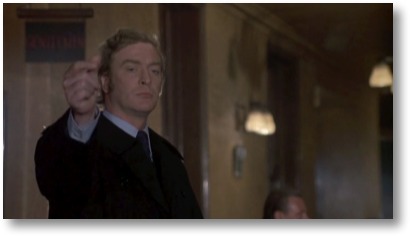
Mike Hodges wrote and directed this now cult classic crime thriller (based on the 1969 novel Jack’s Return Home by Ted Lewis). Michael Cain stars as Jack Carter a London based gangster who travels to the North-East of England (predominantly Newcastle and Gateshead) following the death of his brother in an apparent drink-driving incident.
In a still much debated moment Jack enters a Newcastle pub and asks for a pint of bitter, ‘…in a thin glass’. Many an internet forum is buzzing with the question, why a thin glass. Some cite subtle differences between the way different beverages were served in the North and the South of England at that time, explaining that asking for a thin glass is Jack’s way of acknowledging he is (or was) a local, there is a brief look to an older man also drinking out of a thin glass, perhaps to imply a ‘connection’.
Another theory establishes the reason as far less geographical; Jack is a man from a world of crime, a man accustomed to encountering violence at any moment, someone who might need to find a method of quickly defending himself should trouble occur.
Some sources indicate it as common practice at the time the film was shot to serve bitter in a thicker ‘dimpled’ glass with a handle, looking closely at the scene, although slightly out of focus, a long trail of such glasses are visible along the bar as the camera pans back. In asking for bitter in a thin glass Jack is asking for a glass that he knows will break more easily, thus making it more readily useable as a weapon.
The pub used for this scene was located opposite Newcastle Central train station and known as The Long Bar owing to the fact it once boasted the longest bar in Europe. Alas, this very pub is no more having been demolished soon after filming in 1971; it has since been redeveloped into accommodation.
The nearest pub, which also features in the film (the one where Jack encounters Alun Armstrong’s character), was at the time known as the Victoria and Comet, it has since been re-launched by the Nicholson’s pub chain (having previously been part of an O’Neill’s chain) as the Victoria Comet – offering a return to the old world aesthetic with wooden floors and a Get Carter theme, film memorabilia/tributes now making up part of the decor.
7. Shaun of the Dead (2004) – A Safe Haven
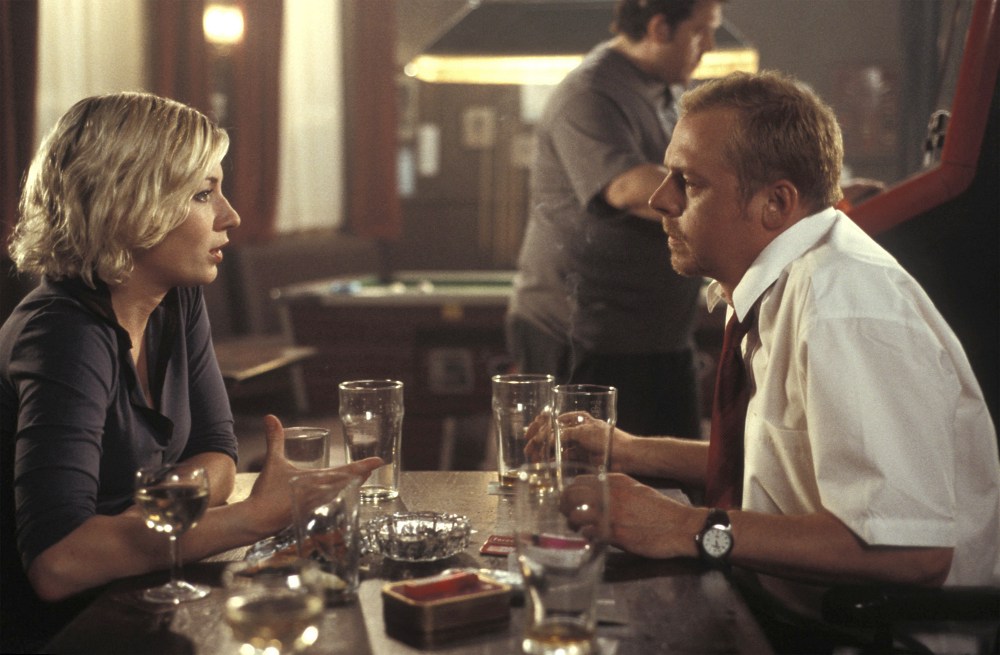
The pub does not always have to be a place of potential conflict, at least until the dead return to walk the earth. The early scenes of Edgar Wright’s comedy-horror establish it as a place of hum-drum banality, a place so secure one may actually forget to live their life. Shaun (Simon Pegg, who also co-scripted the film) is a twenty-nine year old shop salesman with little direction in life, choosing to spend all of his spare time sat in the local pub, The Winchester Tavern, there seems little prospect of change.
The first in Wright’s ‘Three Flavour’s Cornetto Trilogy’ – followed by Hot Fuzz (2007) and later The Worlds End (2013) [see below], the film plays tribute to the zombie films of George A.Romero but, more relevant to this list, also covers the issue of ‘arrested adolescence’. Shaun has failed to progress beyond the point of just hanging around the pub with his friends and fails to shoulder any responsibility, unable to even remember to book a restaurant for an Anniversary date with his girlfriend Liz (Kate Ashford), only a zombie apocalypse can spur him into any action.
As the plot escalates, the one place of refuge is ‘the Winchester’ – as it always has been. For the viewer, Shaun of the Dead offers up the pub as a safe haven, either as a place to shirk the responsibilities of life or use as a port of defence/retreat in a zombie apocalypse. On a thematic level, consider the zombies as walking reminders of Shaun’s own mortality, something he has repressed, something he struggles to defend his pub, his ‘safe haven’, should the zombies take control and force him to confront the passage of his life.
The Winchester Tavern was at the time of filming (May-July 2003) known as the Duke of Albany, a three story Victorian pub, located in New Cross in South London. In 2008 it was converted into flats.
8. Kes (1969) – Everyday Banter
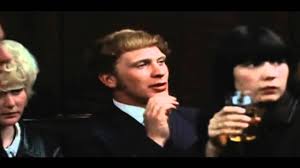
Ken Loach’s film adaptation of Barry Hines’ novel A Kestel for a Knave came towards to the end of the British New Wave film movement (more often referred to as ‘kitchen sink’) and as a result its signature pub scene is shot with the corresponding documentary aesthetic the viewer might expect.
The inconsistent diagetic sound of the band fading in and out between the constant murmur of multiple conversations, fleeting shots of local residents doubling as extras, interspersed with snatches of conversation between the main characters. Here Billy Casper’s (David/Dai Bradley) older half brother Judd (Freddie Fletcher) enjoys a night out with his work colleagues, we see him laugh joke and swill back pints, eventually cutting to an abrasive exchange of words with his Mother (Lynne Perrie) and her most recent partner and divorcee Reg (Joe Miller).
Judd bellows out for all the pub to hear ‘did everybody hear about him last time he got married – he got confetti on elastic that’s how tight fisted he is’, to which Judd’s mother struggles to withstrain Reg as the whole room roars with laughter. Later as the band, finish their cover set of contemporary hits, a singer (comedian Joey Kaye) takes to the stage and sings an innuendo laded song ‘What a Whopper’ about a large marrow – anatomy and growing vegetables, like saving money, being something his audience can all share a common understanding of.
Rather like Passport to Pimlico, the customers are all united both geographically and through their points of reference. The documentary style used within this scene allows a (perhaps arguably slightly tinted) window into a now departed social world as it really was. The ‘everyday working man banter’, the extras caught on camera laughing hysterically and dancing to the marrow song, the pints, the clothes, the girls looking slightly coy as the local lads approach, the hair-cuts and the cigarette smoke is all as it really was at the time.
The pub used in the film was Dards in Cudwoth, Barnsely, South Yorkshire, following several years of uncertainty and despite its ultimately iconic film appearance and still being open for business not long prior, it was finally demolished in April 2013.
9. The World’s End (2013) – The Pub Chain
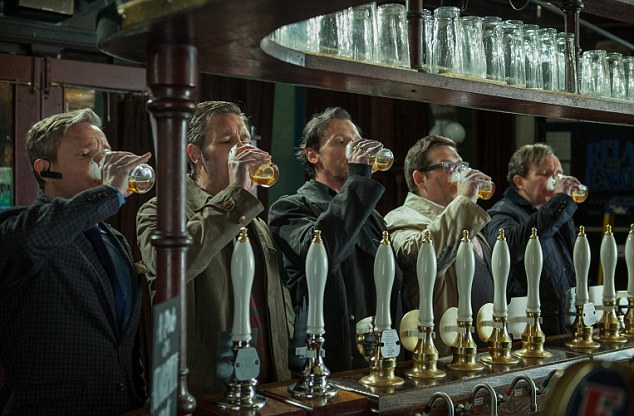
Edgar Wright’s final film of the Three Flavours Cornetto Trilogy, again co-scripted by Simon Pegg, focuses on a group of friends returning to their old home town in order to re-live/re-create a pub crawl they failed to complete over 20 years previous. Pegg stars as Gary King, a 40-something for whom life never has quite progressed, he tracks down his estranged school friends (Nick Frost, Paddy Considine, Eddy Marsden and Martin Freeman) and together they, initially reluctantly, embark of a drinking trek of twelve pubs in one night, culminating it one known as The World’s End.
Partway through this pub-crawl they discover that the whole town is actually steadily being replicated by alien substitutes. These alien substitutes are like the pubs they visit, they might look the same but they are not, they are replications.
Although the theme of ‘arrested adolescence’ is again present, more predominantly than ever in Pegg’s character, of relevance to this list is the social impact of pub chains slowly buying up struggling local pubs in towns throughout Britain. As Wright himself has pointed out, he wanted to capture ‘the bittersweet feeling of returning to your home town and feeling like a stranger’, partially the result of factors such as the ‘homogeneous branding’ of pubs, cafes and restaurants, which he felt was/is becoming ‘like a virus’.
In The World’s End, a pub chain, a series of pubs all run by the same company is likened to a component within an ‘alien network’, slowly turning the nation’s pubs, towns (and the world) into a hollow vessel devoid of the character-full imperfections which make a place ‘human’ – the identikit fake chalkboard signage in all the pubs in the film is meant to reflect this. The name of each pub is supposed to foreshadow events which take place within.
Filming took place in various locations with some in Welwyn Garden City: The First Post, is The Peartree, The Doctor’s Tonic doubles up for the next pub – The Old Familiar, The Cork became The Famous Cock. The Parkway Bar as The Cross Keys heralds the next batch of locations all in Letchworth Garden City: Three Magnets as The Trusty Servant, The Colonade became the Two-Headed Dog, and the Arena Tavern, The Kings Head. The Letchworth Garden City railway station had an exterior make-over to become The Hole in the Wall, whilst the (independent) Broadway cinema in Letchworth, became The Mermaid.
The Broadway was the first cinema outside London to premiere the film. The Good Companions exterior was actually the redressed front of an empty shop (71 Leys Avenue, Letchworth) with the interior shot at the Wenlock Arms, Islington, London. The Beehive is currently a restaurant in Letchworth – The Thai Garden. The World’s End exterior is a pub called the Gardeners Arms located on the Letchworth boundary. Somewhat ironically, Letchworth was built as part of the 1909 ‘new towns’ initiative (yes, that really is the UK’s first roundabout on the film), premises did not gain licences to serve alcohol until 1958.
10. Carry On Abroad (1972) – Nostalgia
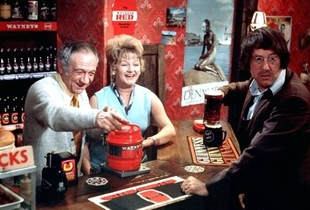
The final entry on this list perhaps epitomises many of the factors on this list whilst also highlighting their continued appeal. In Carry On Abroad, the pub run by Vic Flange (Sid James) bookends the events of the film (a foreign holiday) and represents a safe haven where all can gather familiar to each other and their surrounding whilst engaging in like-minded banter.
In the opening scene a flirty Carry On regular Barbara Windsor asks Sid James’ character if he’s ‘…got a large one?’ to which he replies ‘I’ve had no complaints so far’ before giving his signature laugh. The Carry On films, for all they postured as increasingly sexual were seldom more that mildly saucy, many regarding them as reflecting a nostalgia for the cheeky humour of 1930’s seaside postcards as illustrated by Donald McGill.
Thus, even when new they were echoes of a vanishing Britain, their broad humour perhaps comparable to the kind of everyday banter like-minded work colleagues might engage in at the pub after hours. Humour which it could be said had and perhaps still has as much appeal for being nostalgic as it does comedic.
The increased popularity of the foreign holiday, (the premise behind the film) was signalling a social change in Britain. For many, Carry On Abroad represents the last ‘proper’ Carry On film (in that it is the final film still directed by Gerald Thomas, written by Talbot Rothwell and features all cast members one typically expects to see). By 1972, the kind of pub represented in the film, a localised melting pot of familiar faces, where everybody knows one and other, was, like the Carry On’s and the familiar characters/caricatures within them, in decline. Society and tastes were changing.
As Leon Hunt observed in his examination of 70’s ‘Low Culture’, the pub scenes both at the beginning and end of the film serve to ‘normalise’ the events of the film (an unfamilar foreign holiday) by seeing all the characters unite on its common or ‘home ground’. ‘Sid’s pub’ therefore represents an already nostalgic cinematic (filmed at Pinewood Studios) nod to the pub as a safe haven in a social landscape which was leaving the traditional British pub as many understood it behind. In this sense, ‘Sid’s pub’ represents the British pub like many of the others in list, as a semi-isolated world with rules and conventions all of its own.
Author Bio: George Cromack is a tutor at the University of Hull and also Coventry University’s Scarborough Campuses; with a BA in Scriptwriting he also teaches evening classes in Creative Writing, Scriptwriting and Film Studies for the WEA. Working towards his PhD focusing on Folk Horror, he is a keen writer of both prose and script, Cold Calling, a film short written by George premiered in October 2013. Follow him on Twitter @MadBasil.